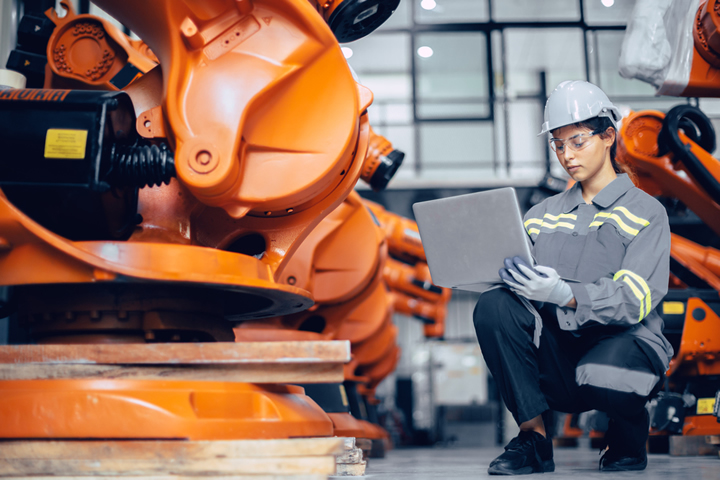Focus on Revitalizing American Manufacturing

As we head into the 2024 election, both parties are making promises of prosperity for the middle class: stable jobs to support middle-class American families. It’s something sorely needed, especially in battleground Midwestern states where the election is typically won. The transition to a service economy has been rough, and many Americans feel they have fallen through a gap between insufficiently low-paying work and professional careers they can’t access. It’s a feeling backed up by numbers, as the percentage of middle-income earners continues to fall. And for both tickets, it may be personal. Republican VP candidate JD Vance famously wrote about the struggles of Appalachia in his memoir Hillbilly Elegy; Democratic VP candidate Tim Walz comes from rural Minnesota, where the poverty rate is higher than in urban areas of the state.
The only sustainable way to cover the middle-class gap is by revitalizing foundational industries, like manufacturing. Unlike other potential economic incentives and stimuli for the middle class, revitalizing manufacturing advances other American goals simultaneously. 2022’s Inflation Reduction Act has drawn $124.7B in investments over 325 major projects in two years and created tens of thousands of jobs in recessed areas. Legislation like The CHIPS and Science Act aims to reduce foreign dependence and strengthen supply chains, but it also reshores manufacturing jobs. Pure stimulus is often a political nonstarter; only by aligning national interest with middle-class prosperity will we achieve either.
What’s critical is that these jobs must remain middle-income jobs, capable of supporting families and local communities. Waves of offshoring in the past chased cheaper labor, but we cannot and should not try to compete on that front: these jobs must be desirable to attract skilled and dedicated workers. Nor should we rely on having these jobs subsidized forever. Government stimulus is a powerful tool to jump-start these industries, but should only be step one of a long-term transformation.
This raises the question: why would manufacturers, with access to the worldwide labor and parts market, work in America with more expensive labor? They won’t do it out of charity. What competitive advantage can America seize over foreign markets? And how can they maintain it, even as manufacturing faces a wave of retirement from many of their most experienced workers?
The answer is technology. It isn’t the first time it will be the answer, and it won’t be the last. Ever since the Industrial Revolution, labor markets have fluctuated in cycles of offshoring and reshoring due to the influence of new manufacturing technologies. The latest technology, whether it’s the assembly line, the industrial robot, or the computer, first emerges in the most modernized countries. A wave of trained labor rises to implement and support it in its home country, but as the technology proliferates around the world, most roles shift offshore to cheaper markets. The starts of these cycles advance the productivity and prosperity of the middle class in modernized countries like America. The ends of these cycles provoke the next technological revolution.
What manufacturers, job-seekers, and the incoming administration need to recognize and capitalize on is that the next revolution is already underway. It’s a constellation of new technologies, including AI generation, big data, image recognition, and more. The previous era of digitization, unfolding mostly since the 1980s, moved data from paper onto computers, but only as static repositories, requiring expertise and manual effort to navigate. This new era makes data intuitive to navigate and understand, connecting human questions to the answers in data smoothly and instantly. It’s the difference between a spreadsheet where one has to memorize row numbers and pore over thousands of cells, and a spreadsheet where one can ask questions in plain English and receive immediate answers.
The upshot of this is a cutting-edge competitive advantage. Manufacturers can compensate for more expensive labor by increasing the productivity of each of their employees. This new type of software essentially gives each worker a personal assistant for each of their duties, accomplishing complex cognitive tasks that would previously require additional workers.
Beyond productivity, this new technology enables manufacturers to be flexible and agile. As opportunities like the Inflation Reduction Act emerge, these new technologies empower manufacturers to leap faster into new production. Often, the critical delay that breaks an opportunity happens on the data management side: companies hesitate to bid on new business as they pull together data to make an estimate or prepare equipment. With this new software making such data collection instantaneous, more companies are ready to produce clean energy products and other vital new industries.
In Japan, where my company CADDi was founded, we faced many of these same challenges. Our aging population has led to a massive labor shortage: 51% of companies report that they don’t have enough employees. Despite that, offshoring Japanese manufacturing work remains relatively rare; instead, companies compensate with more efficiency and productivity per employee. This same mentality will allow America to reshore and revitalize this core industry.
Midwestern states, former manufacturing cities in economic downturns, and other parties depending on a middle-class renaissance are linchpins of the 2024 election. Regardless of who wins, we must demand investment in these sectors to both bolster the middle class and advance other American interests. Whether this stimulus leads to a sustained rejuvenation of American manufacturing depends on companies’ abilities to leverage new technologies and claim the next era of competitive advantage.
Yushiro Kato previously worked for McKinsey & Company, where he co-led the procurement sector for the manufacturing industry. He supported large manufacturers in Chicago, Milwaukee, New Jersey, and more. In November 2017, he founded CADDi with the mission to “unleash the potential of manufacturing.” In 2023, Yushiro was selected as one of the top 10 entrepreneurs by Forbes.
Featured Product

